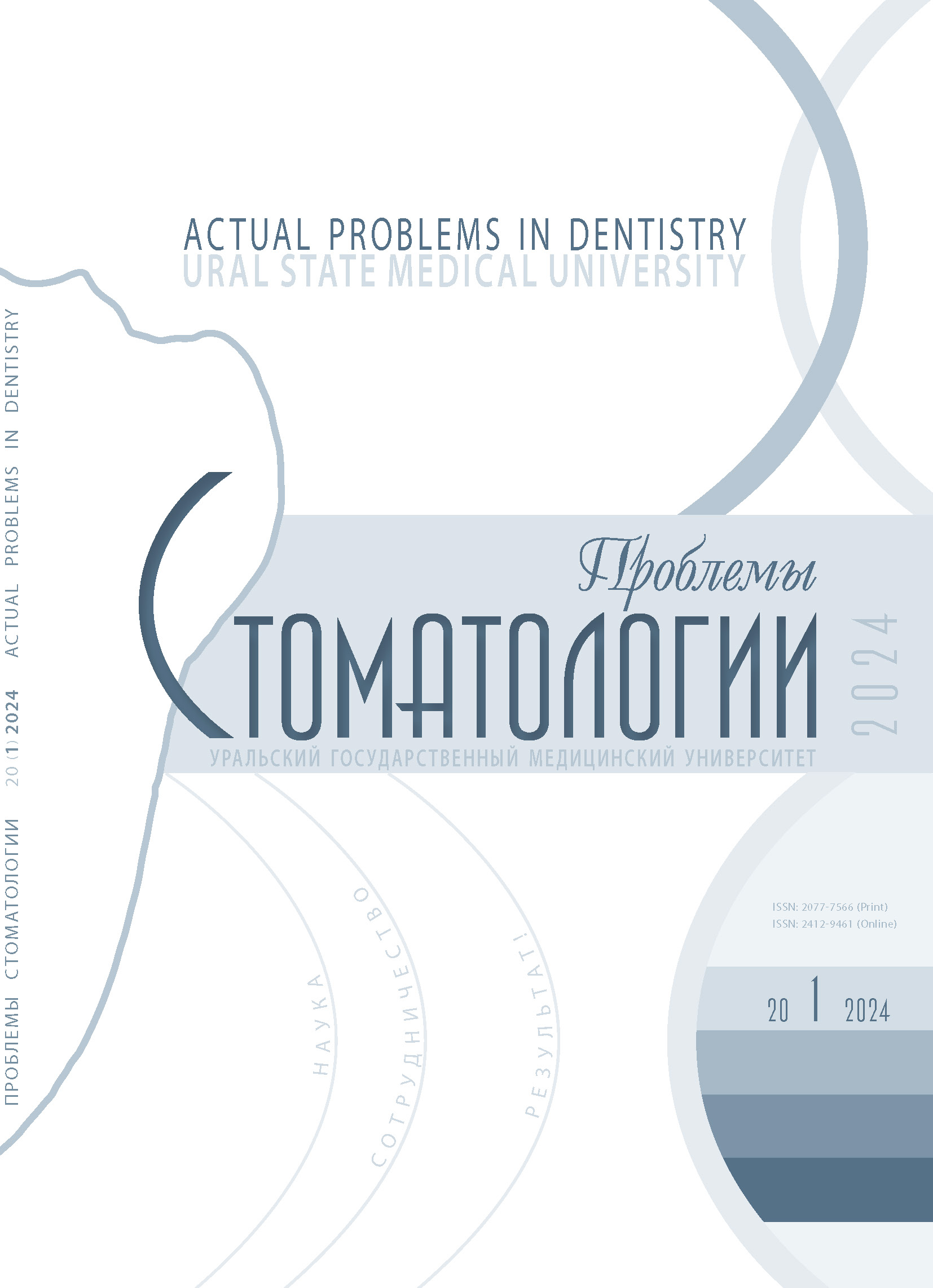Казань, Республика Татарстан, Россия
Чувашский государственный университет имени И. Н. Ульянова (кафедра пропедевтики стоматологических заболеваний и новых технологий, Профессор кафедры)
Чебоксары, Чувашская республика, Россия
УДК 616.31 Стоматология. Заболевания ротовой полости и зубов
В литературе представлены сведения о высокой распространенности заболеваний пародонта и твердых тканей зуба у пациентов психиатрического стационара. Обсуждается связь между микробиотой пародонта и психиатрической патологией и необходимостью поддержания здоровья полости рта среди данной группы больных. Целью исследования являлось изучение структуры заболеваний пародонта у пациентов психиатрического стационара в различных возрастных группах. Материал и методы исследования. В РКПБ им. В.Н. Бехтерева (г. Казань) в период с 2014 по 2018 г. был проведен осмотр полости рта 200 пациентов (95 женщин и 105 мужчин) в возрасте от 35 до 65 лет (средний возраст 56,26 ± 6,74 г.). В анкете фиксировался возраст пациента, пол, диагноз основного заболевания, зубная формула, заполнялась стандартная пародонтограмма. Путем последовательных измерений определялась максимальная глубина пародонтального кармана. Результаты исследования. У 100% пациентов психиатрического стационара было выявлено поражение тканей пародонта, из них у 86,5% — в форме хронического пародонтита. Максимальное количество больных с пародонтитом выявлено в возрастной группе 51–60 лет. Наибольшее количество удаленных зубов — у пациентов в возрасте более 70 лет. Выявлена прямая сильная корреляционная зависимость между возрастом и количеством удаленных зубов (rp = 0,923; р < 0,001). Максимальная глубина пародонтального кармана была также в возрастной группе 51–60 лет и составила 4,25 ± 1,14 мм. Выявлена прямая сильная корреляционная зависимость между глубиной пародонтального кармана и количеством удаленных зубов. Чем глубже у пациента патологические карманы, тем больше зубов подвергается удалению (rp = 0,892). Выводы. Результаты исследования свидетельствуют о необходимости разработки программ обучения пациентов и персонала психиатрических стационаров с целью улучшения качества жизни больных и общего состояния здоровья.
пациенты с психиатрической патологией, хронический пародонтит, удаления зубов, стоматологический статус
1. Елизова Л.А., Атрушкевич В.Г., Орехова Л.Ю. Новая классификация заболеваний пародонта. Пародонтит. Пародонтология. 2021;26(1):80-82. [L.A. Elizova, V.G. Atrushkevich, L.Yu. Orekhova. New classification of periodontal diseases. Periodontitis. Periodontology. 2021;26(1):80-82. (In Russ.)]. https://www.parodont.ru/jour/article/view/433
2. Ильина Р.Ю., Мухамеджанова Л.Р. Причины удаления зубов у пациентов психиатрического стационара. Проблемы стоматологии. 2023;19(3):69-74. [R.Yu. Il'ina, L.R. Muhamedzhanova. Reasons for tooth extraction in psychiatric hospital patients. Actual Problems in dentistry. 2023;19(3):69-74. (In Russ.)]. https://doi.org/10.18481/2077-7566-2023-19-3-69-74
3. Стрельникова Н.В., Антонова А.А., Туркутюков В.Б., Шаповаленко Е.С. Эпидемиология неспецифических пародонтитов, вызванных бактериями рода Leptotrichia, при хроническом и рецидивирующем течении инфекции. ТМЖ. 2018;4(74):34-39. [N.V. Strel'nikova, A.A. Antonova, V.B. Turkutyukov, E.S. Shapovalenko. Epidemiology of nonspecific periodontitis caused by bacteria of the genus Leptotrichia in chronic and recurrent infection. TMG. 2018;4(74):34-39. (In Russ.)]. https://cyberleninka.ru/article/n/epidemiologiya-nespetsificheskih-parodontitov-vyzvannyh-bakteriyami-roda-leptotrichia-pri-hronicheskom-i-retsidiviruyuschem.
4. Araújo MM, Martins CC, Costa LC, Cota LO, Faria RL, Cunha FA, et al.. Association between depression and periodontitis: a systematic review and meta-analysis. J Clin Periodontol. 2016; 43: 216–28. DOI: https://doi.org/10.1111/jcpe.12510
5. Bernabe E., Marcenes W., Hernandez C.R., Bailey J., Abreu L.G., Alipour V. et al. Global, regional, and national levels and trends in burden of oral conditions from 1990 to 2017: a systematic analysis for the global burden of disease 2017 study // J Dent Res. – 2020;99:362-373. DOI:https://doi.org/10.1177/0022034520908533.
6. Denis F., Millot I., Abello N., Carpentier M., Peteuil A., Soudry-Faure A. Study protocol: a cluster randomized controlled trial to assess the effectiveness of a therapeutic educational program in oral health for persons with schizophrenia // Int J Ment Health Syst. – 2016;5:10-65. DOI:https://doi.org/10.1186/s13033-016-0096-0.
7. DiGiulio D.B., Romero R., Amogan H.P. et al. Microbial prevalence, diversity and abundance in amniotic fluid during preterm labor: a molecular and culture-based investigation // PLoS One. – 2008;3(8):e3056. DOI:https://doi.org/10.1371/journal.pone.0003056.
8. Dominy S.S., Lynch C., Ermini F., Benedyk M., Marczyk A., Konradi A. et al. Porphyromonas gingivalis in Alzheimer's disease brains: evidence for disease causation and treatment with small-molecule inhibitors // Sci Adv. – 2019;5:23-44. DOI:https://doi.org/10.1126/sciadv.aau3333
9. Eltas A., Kartalcı S., Eltas S.D. et al. An assessment of periodontal health in patients with schizophrenia and taking antipsychotic medication // Int J Dent Hyg. – 2013;11:78-83. DOIhttps://doi.org/10.1111/j.1601-5037.2012.00558.x
10. Fluegge K. Correspondence: Periodontal Health among Non-Hospitalized Chronic Psychiatric Patients in Mangaluru City-India // J Clin Diagn Res. – 2017;11(1):83-31. DOI:https://doi.org/10.7860/JCDR/2017/24900.9208.
11. Liu F., Wen Y.F., Zhou Y., Lei G., Guo Q.Y., Dang Y.H. et al. A meta-analysis of emotional disorders as possible risk factors for chronic periodontitis // Medicine (Baltimore). – 2018;97:114-134. DOI:https://doi.org/10.1097/md.0000000000011434
12. Martínez M., Postolache T.T., García-Bueno B. et al. The role of the oral microbiota related to periodontal diseases in anxiety, mood and trauma- and stress-related disorders // Front Psychiatry. – 2021;12:81-41. DOI:https://doi.org/10.3389/fpsyt.2021.814177
13. Morales-Chávez M.C., Rueda-Delgado Y.M., Peña-Orozco D.A. Prevalence of bucco-dental pathologies in patients with psychiatric disorders // J Clin Exp Dent. – 2014;6(1):87-111. DOI:https://doi.org/10.4317/jced.51147.
14. Tang W.K., Sun F.C., Ungvari G.S., O'Donnell D. Oral health of psychiatric in-patients in Hong Kong // Int J Soc Psychiatry. – 2004;50(2):186-191. DOI:https://doi.org/10.1177/0020764004043134.
15. Tong S., Lyu Y., Huang W., Zeng R., Jiang R., Lian Q., Leung F.W., Sha W., Chen H. Genetically predicted causal associations between periodontitis and psychiatric disorders // BMJ Ment Health. – 2023;26(1):300-864. DOI:https://doi.org/10.1136/bmjment-2023-300864.
16. Torales J., Barrios I., González I. Oral and dental health issues in people with mental disorders // Medwave. – 2017;17(8):70-145. DOI:https://doi.org/10.5867/medwave.2017.08.7045.
17. Wey M.C., Loh S., Doss J.G., Abu Bakar A.K., Kisely S. The oral health of people with chronic schizophrenia: A neglected public health burden // Aust NZJ Psychiatry. – 2016;50(7):685-694. DOI:https://doi.org/10.1177/0004867415615947.
18. Zheng D.X., Kang X.N., Wang Y.X., Huang Y.N., Pang C.F., Chen Y.X. et al. Periodontal disease and emotional disorders: a meta-analysis // J Clin Periodontol. – 2021;48:180-204. DOI:https://doi.org/10.1111/jcpe.13395



















